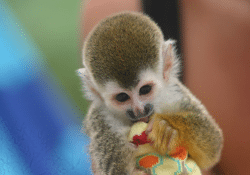Contributed by Wendy Rubiano
Wildlife is made up of a set of organisms that live in natural, temporary or permanent conditions in the national territory, both in the continental, insular and marine territory, that do not require the care of the human being for their survival. The exotic organisms declared as wild by the country of origin and the organisms bred and born in captivity from wild specimens are also considered as wildlife.Despite the reforestation, domestication and illegal trafficking Costa Rica’s wildlife has had to face, the country now working very hard to put itself on the map as world leader in sustainability. A large part of this mission is put into practice by the licensed rescue centers the government as well as private institutions have invested in. Learn all about their history, their mission and how YOU can contribute!
Government Sanctioned Wildlife Institutions
In order to conserve, protect and control wildlife, the Wildlife Conservation Law No. 7317 was created. This law ensures that that activities related to the management and use of wildlife are carried out in a sustainable manner.
All rescue center, nurseries and zoos must be registered in the National System of Conservation Areas (Sinac), which demands a management plan as well as having a biologist and veterinarian on site.
Although the country has 253 establishments that are duly registered, Sinac reported the existence of locations containing wildlife that are not registered. Even some hotels create small rescue centers and often use practices that are not in the best interest of the animals.
According to Sinac, this also encourages wildlife trafficking since some people see an opportunity for profit in selling animals to these hotels or resorts.
“We have learned that people are bringing healthy animals to clandestine rescue centers and the problem with that is that animals that can and should be released, remain on display. People bring to us sick or injured animals that those places refuse to accept.” A ZooAve official reported.
“Unfortunately, people are calling rescue centers and others deliver the animal that is injured or sick to those places, but these establishments do not have the infrastructure, they do not have specialized personnel and often do their best to keep the animal alive just to keep them captive and on display. That’s one of the big problems we’re dealing with“, a veterinarian at the Las Pumas rescue center reported.
There are also establishments that, although with good intentions, care for wild animals but they do not have the necessary knowledge to manage wildlife and this endangers both the person and the animal.
There are people who say they love animals and go to a rescue center. This is where the problem starts because the line between a wild animal and a domesticated animal grows thin.
Sinac’s Plan
Given this situation, Sinac joined forces with the organization Humane Society International (HSI), the School of Veterinary Medicine and the International Institute for Wildlife Management of the National University (UNA) to develop a strategy for the management of wildlife in captivity.
“Currently, there is no updated registry of the places that illegally maintain and manage fauna in captivity. There are dozens of places that handle animals, but the particular situation of each site or the species that manage is unknown same with the number of individuals for each one.“ Sinac said in a press release.
Firstly, a diagnosis will be made to identify the establishments that manage wild animals.
Secondly, the idea is to evaluate the management conditions in which these establishments, their programs and aspects of veterinary medicine operate.
“A large number of unregistered zoos, nurseries, and rescue centers have traditionally been used to locate confiscated or rescued animals, and for some years there has been a boom in the establishment of places dedicated to the management of rescued or confiscated animals. The number of individuals that are in captivity in these establishments is alarming,16 years ago they had in captivity, only in about 30 places, more than 400 red macaws, more than 100 green macaws, more than 80 felines (of six species), in addition to 100 monkeys of the four species that exist in the country“ Sinac explained.
Established Rescue Centers And Their Volunteer Programs
Kids Saving the Rainforest

KSTR was founded in 1999. Two 9-year-old girls wanted to educate people around the world about the ecological importance of the rainforest and organize programs that aim to preserve and protect the rainforest and its wildlife. Additionally, KSTR encourages its volunteers and visitors to introduce sound ecological practices in their homes, schools, and communities.
Volunteer program
Volunteers are the backbone of Kids Saving the Rainforest’s success! If you have a passion for wildlife and you’re looking for a way to volunteer and make a positive change in the world, KSTR should be on the top of your list.
KSTR offers programs for all ages. Volunteers have the opportunity to help monitor, observe, and care for the wild animals.
ZooAve Rescue Center
In 1990, Animal Rescue ZooAve was brought under new management with a improved mission of animal welfare and conservationism. The old ZooAve opened its doors in the 70s. Initially, ZooAve was a small private zoo located in the Garita de Alajuela (in the Central Valley of the country) with the main objective of exhibiting wild animals for profit.
ZooAve’s new management was set on improving conditions for the animals and move them to a property of 14 hectares bordered by the Itiquís River.
Today, ZooAve is a rescue center with the purpose of establishing a modern, conservationist, ethical center focused on animal welfare and environmental education.
Volunteer program
There are three main Animal Rescue ZooAve projects: Tropical Wildlife Rescue Center, Endangered Wild Animal Reproduction Center and the Conservation Park which has 7 hectares of exuberant botanical garden with more than 125 species of animals including birds, mammals and reptiles that have been rescued and, due to injuries or a high level of domestication and or trauma, cannot be returned to their natural habitat.
The spacious enclosures are designed to offer the animals who will live out their lives in captivity the quality of life they would otherwise experience in the wild.
In addition to having its own release site, they also have two other ones: Bosque Escondido Wildlife Refuge consists of 800 hectares, with dry tropical forest, is located in the Nicoya Peninsula and the Wildlife Research and Conservation Center San Josecito located in the southern part of the country Golfito, consists of a coastal valley of an area of approximately 5 km² in the province of Puntarenas.
Volunteers will have the opportunity to visit the Bosque Escondido Wildlife Refuge.
Las Pumas Rescue Center
 The Las Pumas Rescue Center began its works in the early 60’s when the deforestation of Guanacaste was at its peak. At that time, many wild animals lost their habitat and/or were captured by the inhabitants of the area to have them as pets in the house or traffic them illegally.
The Las Pumas Rescue Center began its works in the early 60’s when the deforestation of Guanacaste was at its peak. At that time, many wild animals lost their habitat and/or were captured by the inhabitants of the area to have them as pets in the house or traffic them illegally.
Don Werner Hagnauer migrated to our country from Switzerland in 1959 to work in the well-known Hacienda La Pacifica. In 1971, they bought the Hacienda and proceeding with the agricultural project in a more sustainable way. Meanwhile, Mrs. Lilly Bodmer de Hagnauer, his wife who always had a conservationist vision, began to house animals brought in by people from the area, officials of the Ministry of Environment and Energy (MINAE), and sometimes buying animals so she can give them proper care.
In 1985, they decided to sell La Hacienda and maintain an area of approximately 25 Ha, wherein 1989 they founded what is now known as the Las Pumas Rescue Center. Today, the Hagnauer Foundation, a non-profit organization, is in charge of financing the Las Pumas Rescue Center.
Volunteer program
The Las Pumas Rescue Center opens its doors to national and foreign students interested in internships and university community work.
They work directly with students from the University of Costa Rica, National University, National Technical University and Technical Colleges. Additionally, young people and adults interested in volunteering and learning about the conservation of wildlife and especially wild cats of our country can visit Las Pumas.
There are only 5-8 volunteers/students every year with a minimum stay of one and a half months. The volunteers/students house is equipped to accommodate 4 people.
So even though there are some places that pretend to be rescue centers and don’t care about the animals, we’ve also shown proof that real rescue centers exist and most importantly, they need our help!
You can become an active volunteer or become part of their sponsorship programs and donate directly to their special campaigns.
Here are some links where you can donate directly and support these amazing organizations.
You can also report if you suspect of illegal activity regarding wildlife to Sinac [email protected] and to Minae dialling 1192.
If you find a wild animal in distress please contact Minae or your local rescue center.







Follow Us